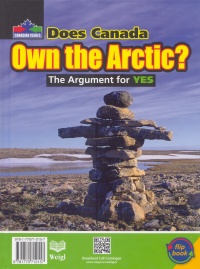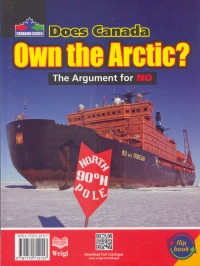| ________________
CM . . .
. Volume XIX Number 24. . . .February 22, 2013
excerpt:
Does Canada Own the Arctic? is a photo book that presents arguments in favour of and against the question posed in the title of the book. The arguments for the two positions are given at opposite sides of the book and reached by flipping the book over. There are seven two-page chapters and seven one-page chapters in each half of the book. Does Canada Own the Arctic? is profusely illustrated throughout with many photographs in colour and has a number of interesting teaching aids. Important terms, such as stewardship are highlighted in bold and definitions given. A number of chapters have interesting sidebars which discuss topics of relevance to the Arctic, such as “Climate Change”. Each section has an “Activity” and a “Quiz”. These and the other aids help to make the book a valuable classroom resource. Debates could be held between students representing the opposing sides of the issue. The research questions in the two “Activity” pages are challenging and will broadly deepen students’ understanding of the Arctic. Finding answers to the leading research question in each section may, however, require more sophistication than the targeted age range possesses. There is no index, list of sources or resources for further study which reduces the book’s value. Arguments in favour of Canadian ownership of the Arctic include the fact that the country can demonstrate that it controls the area and that its citizens, the Inuit, have lived in the Arctic for thousands of years. Canada has plans to develop the region’s resources and to promote the country's sovereignty over the Arctic. In addition, it is implementing plans to protect the Arctic's ecosystem from pollution and climate change. Canada also considers itself the defender of the Arctic. To reinforce this role, it is building a training centre for the military in Resolute Bay and a docking and refuelling centre in Naniscivic for the use of the armed forces. Canada has 11 national parks in the disputed territory, a number of wildlife reserves, bird sanctuaries for migrating birds, and several protected areas for marine life. Opposing Canada’s claims are a number of other northern countries, including Denmark, Russia, the United States, and Finland. All claim to be Arctic nations with claims to the land and sea. Most claims are based on history and have not been agreed to by the international community. Russia claims land in the Arctic because, in the past, its empire extended into the disputed territory. The United States has a claim based on its purchase of Alaska from Russia in 1867. It also says that the Northwest Passage, which Canada claims is in Canadian territory, is an international waterway over which Canada has no control. Some claimants occupy and use the land and water in dispute much as Canada does. Both Russia and the United States have a much stronger presence in the Arctic than Canada does. In addition to the rival land claims challenging Canada's position, there is considerable criticism, by environmental groups of the way Canada has looked after the Arctic environment. It is also argued that shared control of the Arctic would be the best approach to developing the region's resources. Then the citizens of many countries would benefit from resource development. Simon Rose, the author of Does Canada Own the Arctic? has a considerable literary background which includes authoring a number of fantasy and science fiction novels for young readers, with The Emerald Curse and The Time Camera being among them. Rose also conducts workshops and teaches at the University of Calgary. Does Canada Own the Arctic? is well-written, easy to understand and perfect for the intended readership. It is well researched, and the details are accurate. Recommended. Thomas F. Chambers, a retired college teacher and author, lives in North Bay, ON.
To comment
on this title or this review, send mail to cm@umanitoba.ca.
Copyright © the Manitoba Library Association. Reproduction for personal
use is permitted only if this copyright notice is maintained. Any
other reproduction is prohibited without permission.
NEXT REVIEW |
TABLE OF CONTENTS FOR THIS ISSUE
- February 22, 2013.
AUTHORS |
TITLES |
MEDIA REVIEWS |
PROFILES |
BACK ISSUES |
SEARCH |
CMARCHIVE |
HOME |

